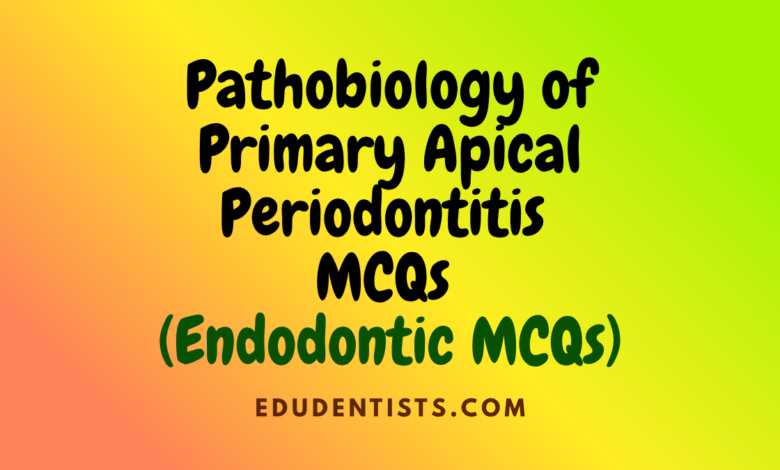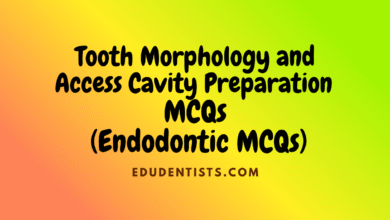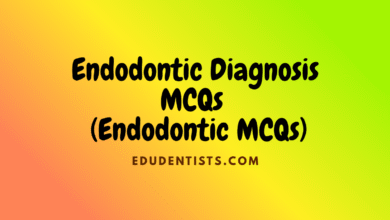Pathobiology of Primary Apical Periodontitis MCQs (Endodontics MCQs)
Pathobiology of Primary Apical Periodontitis MCQs (Endodontics MCQs)

Pathobiology of Primary Apical Periodontitis MCQs _ Endodontics MCQs
Pathobiology of Primary Apical Periodontitis MCQs _ Endodontics MCQs
1. Inflammation of the periapical tissue is sustained by which of the following:
A) Stagnant tissue fluid
B) Necrotic tissue
C) Microorganisms
D) All of the above
2. Acute apical periodontitis is characterized by a focus of:
A) Neutrophils in the lesion
B) Granulomatous tissue in the lesion
C) Lymphocytes, plasma cells, and macrophages in the lesion
3. A periapical true cyst communicates with the root canal, and a periapical pocket cyst does not.
A) True
B) False
4. Which of the following is the most important route by which bacteria are able to invade the dental pulp:
A) The general circulation through anachoresis
B) Exposure to the oral cavity through caries
C) The gingival sulcus
5. Which of the following statements about neutrophils is accurate:
A) They are nonspecific phagocytes.
B) They have a single pathway for intracellular killing.
C) They are mobilized primarily to neutralize bacterial endotoxins.
D) All of the above
6. Which of the following statements about Th1 lymphocytes is accurate:
A) They are thyroid-derived cells.
B) They concentrate in the cortical area of lymph nodes and circulate in the blood.
C) They are responsible for the cell-mediated arm of the immune system.
D) All of the above
7. Which of the following statements about B lymphocytes is accurate:
A) They originally were discovered in an avian gut-associated organ.
B) They account for the majority of circulating lymphocytes.
C) They produce antibodies.
D) All of the above
8. The function(s) of macrophages include(s) which of the following:
A) Phagocytosis of microorganisms
B) Removal of small foreign particles
C) Antigen processing and presentation
D) All of the above
9. Which of the following statements about osteocytes is accurate:
A) They originate as monocytes in the blood.
B) They respond only to mediators released by osteoblasts.
C) They are mononuclear cells capable of bone demineralization.
D) They form a ruffled border away from the bone surface.
10. Which of the following statements about acute apical periodontitis is accurate:
A) It histologically is limited to the periodontal ligament.
B) It is detectable radiographically.
C) It may heal if induced by a noninfectious agent.
D) All of the above
11. Established chronic apical periodontitis is characterized by the predominance of which of the following cells:
A) Red blood cells
B) Epithelial cells
C) Macrophages
D) Neutrophils
12. Lipopolysaccharide (LPS) is released by gram-negative microorganisms only after cell death.
A) True
B) False
13. Which of the following is a function of opsonins:
A) They present antigen.
B) They facilitate phagocytosis.
C) They kill bacteria.
D) They activate the complement system.
14. Effects of interleukin-1 (IL-1) include all of the following except:
A) Stimulation of lymphocytes
B) Leukocyte adhesion
C) Stimulation of bone formation
D) Activation of prostaglandin production
15. Which of the following cytokines is an antiviral protein:
A) Interferon-gamma (IFN-gamma)
B) Interleukin-6 (IL-6)
C) Prostaglandin E2 (PGE2)
D) Tumor necrosis factoralpha (TNF-alpha)
16. Prostaglandins are formed by:
A) Metabolism of arachidonic acid via the lipoxygenase pathway
B) The hydrogen peroxide (H2O2)-halide-myeloperoxidase system
C) Metabolism of arachidonic acid via the cyclooxygenase pathway
D) None of the above





